
Heroin is one of many drugs known as opioids – drugs originating from the opium poppy PAPAVER SOMNIFERUM. Other drugs in the same family include Opium, Morphine, Pethidine, Methadone, Codeine and Wellcanol.
Also known as: Thai white and Brown Sugar
Street names: Unga, Beat and “H”
How is it made?
It is made by treating morphine (an extremely potent pain killer) with various chemicals forming heroin salts – a white powder. This is then “cut” or mixed with other substances, e.g. Brooklax, talcum powder to make it go further. This impure form is street heroin and is brown. This is also known as Brown Sugar. The purer form is known as Thai White.
How is it used?
Heroin can be injected under the skin or directly into a vein. This is called “mainlining” or “spiking’’. It is also sniffed, inhaled or smoked. When heroin is smoked heroin powder is heated in tin foil and the resulting black smoke is then inhaled. This is called “chasing the dragon”.
Symptoms of Heroin abuse:
- Constricted pupils
- Mood swings
- Constipation
- Personality changes
- Loss of appetite and weight
- Sleepiness
- Decreased sex drive
- Slurred speech
Risks of Heroin Abuse
A person can become addicted to heroin after only a few days of using it. This means the person needs more and more of the drug to get high and will experience withdrawal symptoms after stopping.
What are the effects of Heroin?
- “Rush”
- Slowed breathing
- Cloudy thoughts and feeling confused
- Nausea and vomiting
- Spontaneous abortion
- Amenorrhea (Women stop getting their period, the menstrual cycle stops)
What are the long-term effects?
- Addiction
- Infectious diseases e.g. HIV/AIDS and Hepatitis B and C
- Collapsed veins
- Abscesses and sores
- Infection of heart lining and valves
- Arthritis and joint pain
- Accidental death through overdose
Suspicious signs to look for
- Bent & blackened teaspoons
- Blackened tinfoil
- Matchbox covers
- Hypodermic Syringes & needles
- Lemons or packets of citric acid
- Needle marks
- Unidentified tablets, capsules or syrups
- Tourniquet (belt or rubber band used to stop the blood flow so that a vein is visible)
What happens when you STOP using?
Withdrawal symptoms begin within 4-6 hours after the last dose in heavy users. For the first 48-72 hours the symptoms may be painful and unpleasant but is rarely life threatening.
Symptoms include:
- Sweating
- Nausea and vomiting
- Trembling and shaking
- Shortness of breath
- Dizziness
- Pounding heart
- Stomach cramps
- Diarrhoea
- Muscular aches and pains
- Cold, sweaty and covered in goose-flesh (This is often referred to as “cold turkey”)
How to deal with the withdrawal
- Methadone – At the moment in South Africa most of the symptoms of withdrawal can be managed by entering a methadone withdrawal program, where lower and lower doses of methadone are given to prevent unpleasant symptoms. This should be medically supervised by a doctor and is best done in an inpatient program with counselling as there is a risk of the person becoming dependant on methadone.
- Subutex – This seems to be more effective than methadone as it is not as addictive and reduces cravings for heroin. In addition to this it also prevents the person from feeling the high if they use heroin while on the drug.
